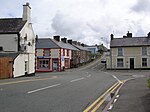Glynllifon
Country houses in WalesGardens in WalesGrade I listed buildings in GwyneddHistory of GwyneddHotels in Gwynedd ... and 6 more
LlandwrogPreserved stationary steam enginesRegistered historic parks and gardens in GwyneddSites of Special Scientific Interest in West GwyneddSpecial Areas of Conservation in WalesTourist attractions in Gwynedd

Glynllifon is the name of the old estate which belonged to the Barons Newborough, near the village of Llandwrog on the main A499 road between Pwllheli and Caernarfon in Gwynedd, Wales. The original mansion was until recently a privately owned hotel.
Excerpt from the Wikipedia article Glynllifon (License: CC BY-SA 3.0, Authors, Images).Glynllifon
A499,
Geographical coordinates (GPS) Address Nearby Places Show on map
Geographical coordinates (GPS)
| Latitude | Longitude |
|---|---|
| N 53.073333333333 ° | E -4.305 ° |
Address
A499
LL54 5SS
Wales, United Kingdom
Open on Google Maps








